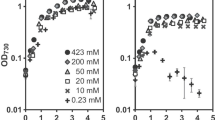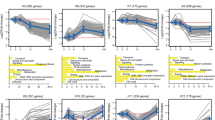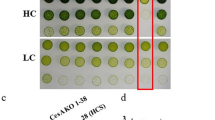Abstract
Many microalgae are capable of acclimating to CO2 limited environments by operating a CO2 concentrating mechanism (CCM), which is driven by various energy-coupled inorganic carbon (Ci; CO2 and HCO3 −) uptake systems. Chlamydomonas reinhardtii (hereafter, Chlamydomonas), a versatile genetic model organism, has been used for several decades to exemplify the active Ci transport in eukaryotic algae, but only recently have many molecular details behind these Ci uptake systems emerged. Recent advances in genetic and molecular approaches, combined with the genome sequencing of Chlamydomonas and several other eukaryotic algae have unraveled some unique characteristics associated with the Ci uptake mechanism and the Ci-recapture system in eukaryotic microalgae. Several good candidate genes for Ci transporters in Chlamydomonas have been identified, and a few specific gene products have been linked with the Ci uptake systems associated with the different acclimation states. This review will focus on the latest studies on characterization of functional components involved in the Ci uptake and the Ci-recapture in Chlamydomonas.

Similar content being viewed by others
References
Amoroso G, Sültemeyer D, Thyssen C, Fock HP (1998) Uptake of HCO3 − and CO2 in cells and chloroplasts from the microalgae Chlamydomonas reinhardtii and Dunaliella tertiolecta. Plant Physiol 116:193–201
Badger MR, Price GD (2003) CO2 concentrating mechanisms in cyanobacteria: molecular components, their diversity and evolution. J Exp Bot 54:609–622
Burow MD, Chen ZY, Mouton TM, Moroney JV (1996) Isolation of cDNA clones of genes induced upon transfer of Chlamydomonas reinhardtii cells to low CO2. Plant Mol Biol 31:443–448
Chen ZY, Lavigne LL, Mason CB, Moroney JV (1997) Cloning and overexpression of two cDNAs encoding the low-CO2-inducible chloroplast envelope protein LIP-36 from Chlamydomonas reinhardtii. Plant Physiol 114:265–273
Duanmu D, Wang Y, Spalding MH (2009a) Thylakoid lumen carbonic anhydrase (CAH3) mutation suppresses air-dier phenotype of LCIB mutant in Chlamydomonas reinhardtii. Plant Physiol 149:929–937
Duanmu D, Miller AR, Horken KM, Weeks DP, Spalding MH (2009b) Knockdown of a limiting-CO2-inducible gene HLA3 decreases bicarbonate transport and photosynthetic Ci-affinity in Chlamydomonas reinhardtii. Proc Natl Acad Sci USA 106:5990–5995
Durai S, Mani M, Kandavelou K, Wu J, Porteus MH, Chandrasegaran S (2005) Zinc finger nucleases: custom-designed molecular scissors for genome engineering of plant and mammalian cells. Nucleic Acids Res 33:5978–5979
Fukuzawa H, Miura K, Ishizaki K, Kucho KI, Saito T, Kohinata T, Ohyama K (2001) Ccm1, a regulatory gene controlling the induction of a carbon-concentrating mechanism in Chlamydomonas reinhardtii by sensing CO2 availability. Proc Natl Acad Sci USA 98:5347–5352
Funke RP, Kovar JL, Weeks DP (1997) Intracellular carbonic anhydrase is essential to photosynthesis in Chlamydomonas reinhardtii at atmospheric levels of CO2. Plant Physiol 114:237–244
Galvan A, Rexach J, Mariscal V, Fernandez E (2002) Nitrite transport to the chloroplast in Chlamydomonas reinhardtii: molecular evidence for a regulated process. J Exp Bot 53:845–853
Giordano M, Beardall J, Raven JA (2005) CO2 concentrating mechanisms in algae: mechanisms, environmental modulation and evolution. Annu Rev Plant Biol 56:99–131
Im CS, Grossman AR (2002) Identification and regulation of high light-induced genes in Chlamydomonas reinhardtii. Plant J 30:301–313
Im CS, Zhang Z, Shrager J, Chang CW, Grossman AR (2003) Analysis of light and CO2 regulation in Chlamydomonas reinhardtii using genome-wide approaches. Photosynth Res 75:111–125
Kaplan A, Reinhold L (1999) The CO2-concentrating mechanism of photosynthetic microorganisms. Annu Rev Plant Physiol Plant Mol Biol 50:539–570
Karlsson J, Ramazanov Z, Hiltonen T, Gardeström P, Samuelsson G (1994) Effect of vanadate on photosynthesis and the ATP/ADP ratio in low-CO2-adapted Chlamydomonas reinhardtii cells. Planta 192:46–51
Karlsson J, Clarke AK, Chen ZY, Hugghins SY, Youn-II P, Husic HD, Moroney JV, Samuelsson G (1998) A novel α-type carbonic anhydrase associated with the thylakoid membrane in Chlamydomonas reinhardtii is required for growth at ambient CO2. EMBO J 17:1208–1216
Katoh A, Lee K, Fukuzawa H, Ohyama K, Ogawa T (1996a) A cemA homologue essential to CO2 transport in the cyanobacterium, Synechocystis PCC6803. Proc Natl Acad Sci USA 93:4006–4010
Katoh A, Sonoda M, Katoh H, Ogawa T (1996b) Absence of light-induced proton extrusion in cotA-less mutant of Synechocystis sp. strain PCC6803. J. Bacteriol 178:5452–5455
Kustu S, Inwood W (2006) Biological gas channels for NH3 and CO2: evidence that Rh (Rhesus) proteins are CO2 channels. Transfus Clin Biol 13:103–110
Li T, Huang S, Jiang WZ, Wright D, Spalding MH, Weeks DP, Yang B (2011) TAL nucleases (TALNs): hybrid proteins composed of TAL effectors and FokI DNA-cleavage domain. Nucleic Acids Res 39:359–372
Mariscal V, Moulin P, Orsel M, Miller AJ, Fernández E, Galván A (2006) Differential regulation of the Chlamydomonas Nar1 gene family by carbon and nitrogen. Protist 157:421–433
Markelova A, Sinetova M, Kupriyanova E, Pronina A (2009) Distribution and functional role of carbonic anhydrase Cah3 associated with thylakoid membranes in the chloroplast and pyrenoid of Chlamydomonas reinhardtii. Russ J Plant Physiol 56:761–768
Mitra M, Lato SM, Ynalvez RA, Xiao Y, Moroney JV (2004) Identification of a new chloroplast carbonic anhydrase in Chlamydomonas reinhardtii. Plant Physiol 135:173–182
Mitra M, Mason CB, Xiao Y, Ynalvez RA, Lato SM, Moroney JV (2005) The carbonic anhydrase gene families of Chlamydomonas reinhardtii. Can J Bot 83:780–795
Miura K et al (2004) Expression profiling-based identification of CO2-responsive genes regulated by CCM1 controlling a Carbon-concentrating mechanism in Chlamydomonas reinhardtii. Plant Physiol 135:1595–1607
Molnar A, Bassett A, Thuenemann E, Schwach F, Karkare S, Ossowski S, Weigel D, Baulcombe D (2009) Highly specific gene silencing by artificial microRNAs in the unicellular alga Chlamydomonas reinhardtii. Plant J 58:165–174
Moroney JV, Ynalvez RA (2007) Proposed carbon dioxide concentrating mechanism in Chlamydomonas reinhardtii. Eukaryot Cell 6:1251–1259
Moroney JV, Husic HD, Tolbert NE (1985) Effect of carbonic anhydrase inhibitors on inorganic carbon accumulation by Chlamydomonas reinhardtii. Plant Physiol 79:177–183
Ohnishi N, Mukherjeeb B, Tsujikawaa T, Yanasea M, Nakanoa H, Moroneyb J, Fukuzawaa H (2010) Expression of a low-CO2-inducible protein, LCI1, increases inorganic carbon uptake in the green alga Chlamydomonas reinhardtii. Plant Cell 22:3105–3117
Omata T, Price G, Badger M, Okamura M, Gohta S, Ogawa T (1999) Identification of an ATP-binding cassette transporter involved in bicarbonate uptake in the cyanobacterium Synechococcus sp. strain PCC 7942. Proc. Natl. Acad. Sci. USA 96:13571–13576
Palmqvist K, Sjöberg S, Samuelsson G (1988) Induction of inorganic carbon accumulation in the unicellular green algae Scenedesmus obliquus and Chlamydomonas reinhardtii. Plant Physiol 87:437–442
Pollock SV, Prout DL, Godfrey AC, Lemaire SD, Moroney JV (2004) The Chlamydomonas reinhardtii proteins Ccp1 and Ccp2 are required for long-term growth, but are not necessary for efficient photosynthesis, in a low-CO2 environment. Plant Mol Biol 91:505–513
Price GD, Maeda SI, Omata T, Badger MR (2002) Modes of active inorganic carbon uptake in the cyanobacterium, Synechococcus sp. PCC7942. Funct Plant Biol 29:131–149
Price GD, Badger MR, Woodger FJ, Long BM (2008) Advances in understanding the cyanobacterial CO2-concentrating mechanism (CCM): functional components, Ci transporters, diversity, genetic regulation and prospects for engineering into plants. J Exp Bot 59:1441–1461
Ramazanov Z, Mason CB, Geraghty AM, Spalding MH, Moroney JV (1993) The low CO2-inducible 36 kDa protein is localized to the chloroplast envelope of Chlamydomonas reinhardtii. Physiol Plant 84:502–508
Raven JA, Cockell CS, De La Rocha CL (2008) The evolution of inorganic carbon concentrating mechanisms in photosynthesis. Philos Trans R Soc B 363:2641–2650
Rolland N, Dorne AJ, Amoroso G, Sültemeyer DF, Joyard J, Rochaix JD (1997) Disruption of the plastid ycf10 open reading frame affects uptake of inorganic carbon in the chloroplast of Chlamydomonas. EMBO J 16:6713–6726
Schroda M (2006) RNA silencing in Chlamydomonas: mechanisms and tools. Curr Genet 49:69–84
Soupene E, King N, Feild E, Liu P, Niyogi KK, Huang CH, Kustu S (2002) Rhesus expression in a green alga is regulated by CO2. Proc Natl Acad Sci U S A 99:7769–7773
Soupene E, Inwood W, Kustu S (2004) Lack of the Rhesus protein Rh1 impairs growth of the green alga Chlamydomonas reinhardtii at high CO2. Proc Natl Acad Sci U S A 101:7787–7792
Spalding MH (2008) Microalgal carbon-dioxide-concentrating mechanisms: Chlamydomonas inorganic carbon transporters. J Exp Bot 59:1463–1473
Spalding MH (2009) The Chlamydomonas sourcebook: organellar and metabolic processes, vol 2, 2nd edn, chap 8. Academic Press, San Diego, pp 257–301
Spalding MH, Jeffrey M (1989) Membrane-associated polypeptides induced in Chlamydomonas by limiting CO2 concentrations. Plant Physiol 89:133–137
Spalding MH, Spreitzer RJ, Ogren WL (1983a) Carbonic anhydrase-deficient mutant of Chlamydomonas reinhardtii requires elevated carbon dioxide concentration for photoautotrophic growth. Plant Physiol 73:268–272
Spalding MH, Spreitzer RJ, Ogren WL (1983b) Reduced inorganic carbon transport in a CO2-requiring mutant of Chlamydomonas reinhardtii. Plant Physiol 73:273–276
Sültemeyer DF, Klöck G, Kreuzberg K, Fock HP (1988) Photosynthesis and apparent affinity for dissolved inorganic carbon by cells and chloroplasts of Chlamydomonas reinhardtii grown at high and low CO2 concentrations. Planta 176:256–260
Sültemeyer DF, Miller AG, Espie GS, Fock HP, Canvin DT (1989) Active CO(2) transport by the green alga Chlamydomonas reinhardtii. Plant Physiol 89:1213–1219
Van K, Wang Y, Nakamura Y, Spalding MH (2001) Insertional mutants of Chlamydomonas reinhardtii that require elevated CO2 for survival. Plant Physiol 127:607–614
Vance P, Spalding MH (2005) Growth, photosynthesis and gene expression in Chlamydomonas over a range of CO2 concentrations and CO2/O2 ratios: CO2 regulates multiple acclimation states. Can J Bot 83:796–809
Wang Y, Spalding MH (2006) An inorganic carbon transport system responsible for acclimation specific to air levels of CO2 in Chlamydomonas reinhardtii. Proc Natl Acad Sci USA 103:10110–10115
Xiang Y, Zhang J, Weeks DP (2001) The cia5 gene controls formation of the carbon concentrating mechanism in Chlamydomonas reinhardtii. Proc Natl Acad Sci USA 98:5341–5346
Yamano T, Fukuzawa H (2009) Carbon-concentrating mechanism in a green alga, Chlamydomonas reinhardtii, revealed by transcriptome analysis. J Basic Microbiol 49:42–51
Yamano T, Miura K, Fukuzawa H (2008) Expression analysis of genes associated with the induction of the carbon-concentrating mechanism in Chlamydomonas reinhardtii. Plant Physiol 147:340–354
Yamano T, Tsujikawa T, Hatano K, Ozawa SI, Takahashi Y, Fukuzawa H (2010) Light and low-CO2 dependent LCIB/LCIC complex localization in the chloroplast supports the carbon-concentrating mechanism in Chlamydomonas reinhardtii. Plant Cell Physiol 51:1453–1468
Yoshihara C, Inoue K, Schichnes D, Ruzin S, Inwood W, Kustu S (2008) An Rh1-GFP fusion protein is in the cytoplasmic membrane of a white mutant strain of Chlamydomonas reinhardtii. Mol Plant 1:1007–1020
Yoshioka S, Taniguchi F, Miura K, Inoue T, Yamano T, Fukuzawa H (2004) The novel Myb transcription factor LCR1 regulates the CO2-responsive gene Cah1, encoding a periplasmic carbonic anhydrase in Chlamydomonas reinhardtii. Plant Cell 16:1466–1477
Zhao T, Wang W, Bai X, Qi Y (2009) Gene silencing by artificial microRNAs in Chlamydomonas. Plant J 58:157–164
Acknowledgments
This research was supported by the National Research Initiative Competitive Grant no. 2007-35318-18433 from the U.S. Department of Agriculture (to M.H.S.), as well as by the College of Agriculture and Life Sciences and the College of Liberal Arts and Sciences at Iowa State University.
Author information
Authors and Affiliations
Corresponding author
Rights and permissions
About this article
Cite this article
Wang, Y., Duanmu, D. & Spalding, M.H. Carbon dioxide concentrating mechanism in Chlamydomonas reinhardtii: inorganic carbon transport and CO2 recapture. Photosynth Res 109, 115–122 (2011). https://doi.org/10.1007/s11120-011-9643-3
Received:
Accepted:
Published:
Issue Date:
DOI: https://doi.org/10.1007/s11120-011-9643-3




